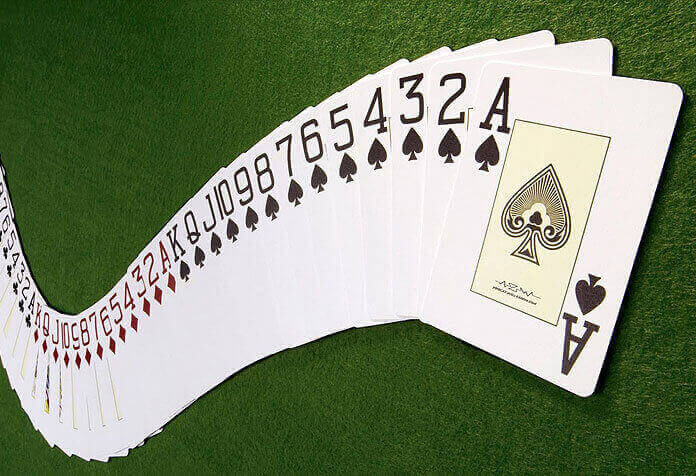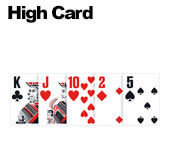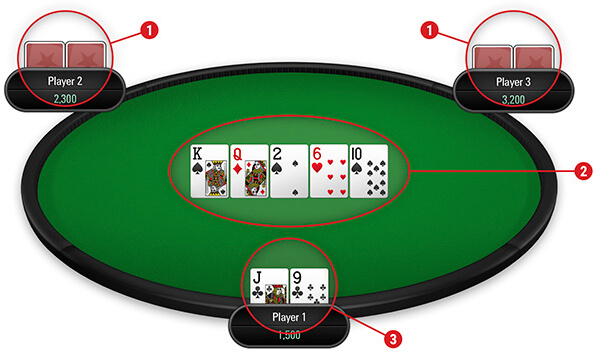
Rules of online poker
On our site you will find the most popular poker games in the world, including Texas Hold'em, Omaha, and many more.
How do you win?
Generally, the winner of each poker hand is either the player with the highest value hand after all the cards are revealed at the end of the current hand (known as the "final showdown"), or the player who makes the last bet not matched by anyone else and thus wins without having to reach the confrontation.
Not sure if a flush beats a straight? Don't you remember which hands make a full house? The strongest hands are on the top row, left to right, while the weakest possible hand is a simple high card.




How to start?
Poker games often include a mandatory bet, such as the big blind and small blind in Hold'em and Omaha. These compulsory bets are the starting point for any poker hand, the first incentive players have to win the hand. The action from subsequent betting rounds further increases the size of the pot.
Deal of cards and betting rounds
After dealing the opening cards, players must take turns taking turns, clockwise.
Each player can usually perform one of the following actions when it is their turn to act:
- Check : Check is to avoid the opportunity to open bets. Players can only check if there are no bets during the current round, and after doing so it is up to the next player to intervene in a clockwise direction. If all active players check, they are still in the hand and the round is over.
- Bet: : Players can bet if there are no others to do so during the current round. Once a bet is made, the other players have to "match" the amount of the bet to stay in the hand.
- Don't Call: Players who fold lose their cards and cannot win or intervene again during the current hand.
- Match: Players who fold lose their cards and cannot win or intervene again during the current hand. Call - Players can call if other players have bet during the current round; To do so, they must match the highest bet made.
- Raise: Players can raise if other players have bet during the current round; To do this, they must match the highest bet made and then place a higher bet. All subsequent players will have to call the raise or raise ("re-raise") the bet to stay in the hand.
Different rounds of betting are used in different poker variants. Texas Hold'em and Omaha are two of the most popular poker games in the world, and their betting structures are identical: four rounds of betting called preflop, flop, turn, and river.
The preflop betting round begins as soon as all players have received their hole cards, before any of the community cards are dealt; bets on the flop take place after the first three community cards have been dealt; those on the turn, after having dealt the fourth community card; and those on the river, after dealing the fifth and last community card.
In each betting round, bets continue until all players have matched the bets placed or have folded (if no bets are placed, the round is completed after all players have passed).
When the betting round is over, the next betting or dealing round begins, or the hand is completed.
Here's an example of a Texas Hold'em hand after all the cards have been dealt. As you can see, players can use either of their two hole cards with any of the five community cards to make the best possible five-card hand; in this case, you can use your two hole cards and three of the community cards to make a straight.

- Your opponents' hole cards
- Community letters
- Your hole cards
Final showdown
After the last bet or raise is called during the final betting round, the showdown takes place; still active players must show or announce their hands, and the player (s) with the strongest hand wins the pot.
Players often show their hands in order rather than all at once. Several players can share a pot, and the pot is distributed in different ways depending on the rules of the game and the rating of each player's hand compared to that of their rivals.
Bet limits
Betting limits refer to the amount with which the jurors can open and raise. In general, in poker games we find the following types: no limit, pot limit or fixed limit.
- No limit: in poker games with no limit betting structure, each player can bet or raise any amount, up to betting all the chips they have at any given time, in any betting round, and whenever it is their turn to intervene.
- Pot Limit: In games with a pot limit betting structure, each player can bet or raise any amount, up to a maximum of the total pot size at that time.
- Fixed Limit: In fixed limit betting structure poker games, each player can call, bet or raise, but only a fixed amount.
In no limit and pot limit games, the "Bets" column in the lobby of some poker software indicates the small blind and big blind of the game, while in mixed games the bets that appear in the lobby are the amounts bet in the case of limit games; in pot limit and no limit rounds, the blinds are generally half the size of the blinds in limit games.
Table and all-in bets
You may have seen a poker scene in a movie or on TV in which a player is faced with a bet of more chips than he has, and is forced to play a watch, a car, or some other possession to continue playing. hand. This can be a source of tension, but poker is rarely played like this in real life.
All games on our site are played with so-called "table stakes", which means that only the chips that were in play at the beginning of each hand can be used throughout a hand. The "table stakes" rule has an application called the "all-in" rule, which dictates that a player cannot be forced to forfeit a poker hand due to not having enough chips to call a bet.
If a player does not have enough chips to call a bet, he is determined to go all-in. The player can win the portion of the pot that is triggered by his last bet. Subsequent actions by other players will be part of a "side pot", which cannot be won by the player who has gone all-in. If more than one player goes all-in during a hand, there may be more than one side pot.
Now that you know the rules, what's stopping you? Download and play!
Add Comments
Give us your opinion is very important.
